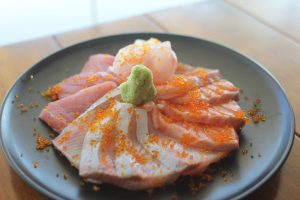5.5 The Conjunction でも (demo)
Discover the power of the conjunction でも (demo), which will brings depth and complexity to your Japanese conversations.
The conjunction でも (demo) in Japanese means ‘but’ or ‘however’. It is used to express a contrast between two ideas or to introduce a contrasting thought. It is used to link two contrasting sentences, but it cannot be used to link nouns or other non-sentential elements.
For example, you could use でも to connect two contrasting sentences, such as ‘I like sashimi’ and ‘I don’t like wasabi’ in Japanese. The sentence would be:

さしみが好(す)きです。でも、わさびは好きじゃないです。
Sashimi ga suki desu. Demo, wasabi wa suki janai desu.
I like sashimi, but I don’t like wasabi.
Here, でも is used to connect the contrasting ideas of liking sashimi but not liking wasabi.
Just a quick note: If you are wondering about when to use the particles は and が with the adjectives 好(す)き(な)and 嫌(きら)い(な), you will find the explanation in Module 3.3.
Exercise 1
Figures
1 “Sashimi and Wasabi” by pelambung. PxHere. Licensed under CC 0.

